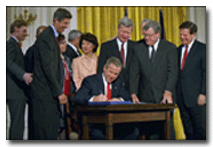C
ongress has granted President Bush broad new international trade negotiating authority
that many expect will bring about major changes in the world of textile and apparel trade.
It won’t be a revolution; it’s more of an evolution. Initially, there is not likely to be a
major increase in imports, except for a few products, such as T-shirts and some others that are
being sewn in the Caribbean. For the longer term, it will mean U.S. textile manufacturers and
importers will have to take a hard look at just where they will fit in an increasingly globalized
textile and apparel industry.
Bill Praised And Damned
As the bill neared final passage in the Senate, Van May, chairman of the American Textile
Manufacturers Institute (ATMI), pointed out that this year, the U.S. textile industry has lost
67,000 jobs and closed 116 textile plants. He said the bill “fails to recognize our suffering, but
will exacerbate it.” Because of the Andean and African preferences in the bill and other
import-liberalization provisions, ATMI opposed its passage.
U.S. Trade Representative Robert Zoellick was effusive in his praise of the bill, saying it
was a “landmark victory” that will enable the administration to advance its international trade
agenda. In particular, he said the legislation will open America’s markets “right away” to
developing countries in Africa, Latin America and the Caribbean.
Zoellick said the bill will help the United States play a stronger role in the global
negotiations that are in their preliminary stages at the World Trade Organization (WTO), and he
also believes the new TPA authority will help the United States move forward immediately with
bilateral negotiations with Chile and Singapore. Those negotiations have been sidetracked for some
time because the president lacked authority to negotiate without fear of second-guessing by
Congress.
Textile and apparel importers were generally pleased with the legislation. Kevin M. Burke,
president of the American Apparel and Footwear Association (AAFA), said the legislation contains “
many initiatives that will help our industry compete in the future.” Julia K. Hughes, vice
president for international trade and government relations for the U.S. Association of Importers of
Textiles and Apparel (USITA), pretty much echoed his sentiments, adding that she sees many
opportunities to develop new partnerships and markets in the Western Hemisphere, where proximity to
U.S. customers is increasingly important for just-in-time manufacturing and deliveries.

President Bush signs the Trade Act of 2002. Photographed by Tina Hager.
What It All Means
Recognizing that the legislation is a done deal, ATMI President Parks D. Shackelford said his
organization now will concentrate on seeing that existing trade laws are enforced, including better
Customs policing of transshipments and other forms of illegal trade. ATMI will continue to oppose
any speed-up in the timetable for eliminating quotas by 2005, and it will press for other nations
to bring tariffs down to U.S. levels, before any additional reductions in U.S. tariffs are
considered in the WTO negotiations. In connection with any future bilateral negotiations, ATMI will
seek rules of origin that will protect U.S. manufacturers.
Hughes says the increased trade with the Sub-Saharan African and Andean nations that is of
such concern to ATMI should not be a problem for the U.S. industry, because those nations are only
minor players in the overall trade picture. She does not foresee any major increases in imports
from those areas but gradual growth. She does, however, see the possibility of a shift in sourcing
away from Asia to Western Hemisphere manufacturers, primarily because of their proximity to U.S.
markets and a growing concern by manufacturers, retailers and lawmakers over working conditions and
environmental considerations in trading nations.
Because the legislation created new or increased quotas for apparel from the Andean, African
and CBI nations, there is an opportunity for U.S. manufacturers to sell more yarn and fabric in
those areas, at least for the short term. The increased apparel quotas for the CBI have a
requirement that U.S. yarn must be used in order for the apparel to qualify. Large, regional fabric
use quotas also were created for the Andean and African nations. At the present time, those
countries do not have the capability to fill the needs of the increased apparel quotas, and this
opens up opportunities for U.S. fabric and yarn manufacturers to establish partnerships with
cutters and sewers in those areas until such time as they develop their own capabilities.
The Role Of ATTAC
The newly-formed American Textile Trade Action Coalition (ATTAC), headed up by Roger Milliken
and textile union UNITE’s Bruce Raynor, will be pursuing many of the same goals as ATMI, but how
closely these efforts will be coordinated remains to be seen. ATTAC’s Washington consultant, Auggie
Tantillo, said his organization’s primary goal is preserving textile jobs, and it will align itself
with organizations and lawmakers who can further that goal.
He emphasized the importance of what’s in the final package and all of the details in
agreements. With respect to some of the upcoming issues, ATTAC will seek in any future bilateral
agreements, rules of origin that are at least as strong as those in the North American Free Trade
Agreement (NAFTA), and it will press the U.S. government to keep textile and apparel tariffs at
their present levels and resist any future cuts until other countries reduce theirs.
A Big Job Ahead
With the new legislation on the books, but subject to wide-ranging interpretations, the textile
industry and importers face an enormous job of sorting out just how the law can be used to benefit
them. Up until now, the Bush administration has remained committed to the nine-point program
announced last December to help the industry through its current times of difficulty.
Commerce Secretary Don Evans has formed an interagency Textile Working Group with eight task
forces that will recommend actions, including establishing trade negotiating objectives, ways to
improve enforcement of existing trade agreements, and ways to get greater overseas market access
for U.S. textiles and apparel.
Importers will be looking for more flexibility and fewer restrictions in trade agreements,
and opportunities to develop long-term relationships with reliable vendors and partners throughout
the world. All of this will be aimed at doing business in what will be a vastly changed, quota-free
textile world in 2005.
Trade Act Of 2002
The basic Trade Act passed by Congress gives President Bush trade promotion authority (TPA),
which will enable him to negotiate international trade agreements that can only be accepted or
rejected, but not amended, by Congress. However, as Congress is often wont to do, it added several
more provisions to the bill that will have a direct effect on textile and apparel trade. In its
final form, the Trade Act of 2002:
• Eliminates a Senate-approved provision sponsored by Sen. John Edwards (D-N.C.) that laid
out specific textile negotiating objectives, which, among other things, said the U.S. should not
reduce its tariffs until other nations bring theirs down to U.S. levels. A Senate/House conference
committee substituted watered-down, generalized language that industry trade experts feel will be
meaningless where textiles are concerned.
• Increases the amount of apparel made of African fabric and yarn that can enter the U.S.
duty-free, which could amount to more than a billion square meters a year by 2005. The bill did
contain a stipulation that third-country (Asian) fabric and yarn cannot be used under the increased
cap.
• Provides for a major increase in the amount of knit apparel made of Caribbean fabric that
can enter the U.S. duty-free.
• For the first time, includes textiles and apparel in the trade preferences granted to the
Andean nations of Colombia, Peru, Ecuador and Bolivia. In the first year, this will allow duty-free
treatment of up to 320 million square meters of apparel, and this eventually could increase to a
billion square meters.
• Weakens language designed to protect U.S. anti-dumping and other laws designed to combat
unfair trade practices.
• Liberalizes adjustment assistance given to workers whose jobs are displaced by imports.
September 2002




